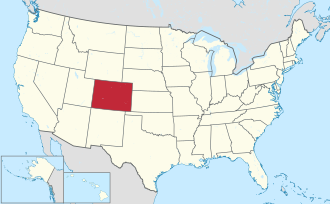Gilpin County | |
|---|---|
 The Gilpin Combined Court, the county courthouse. | |
 Location within the U.S. state of Colorado | |
 Colorado's location within the U.S. | |
| Coordinates: 39°52′N105°31′W / 39.86°N 105.52°W | |
| Country | |
| State | |
| Founded | November 1, 1861 |
| Named after | William Gilpin |
| Seat | Central City |
| Largest city | Central City |
| Area | |
• Total | 150 sq mi (390 km2) |
| • Land | 150 sq mi (390 km2) |
| • Water | 0.4 sq mi (1.0 km2) 0.2% |
| Population (2020) | |
• Total | 5,808 |
• Estimate (2024) | 5,963 |
| • Density | 39/sq mi (15/km2) |
| Time zone | UTC−7 (Mountain) |
| • Summer (DST) | UTC−6 (MDT) |
| Congressional district | 2nd |
| Website | gilpincounty |
Gilpin County is a county located in the U.S. state of Colorado, smallest in land area behind only the City and County of Broomfield. As of the 2020 census, the population was 5,808. [1] The county seat is Central City. [2] The county was formed in 1861, while Colorado was still a territory, and was named after Colonel William Gilpin, [3] the first territorial governor. Gilpin County is part of the Denver-Aurora-Lakewood, CO Metropolitan Statistical Area.




